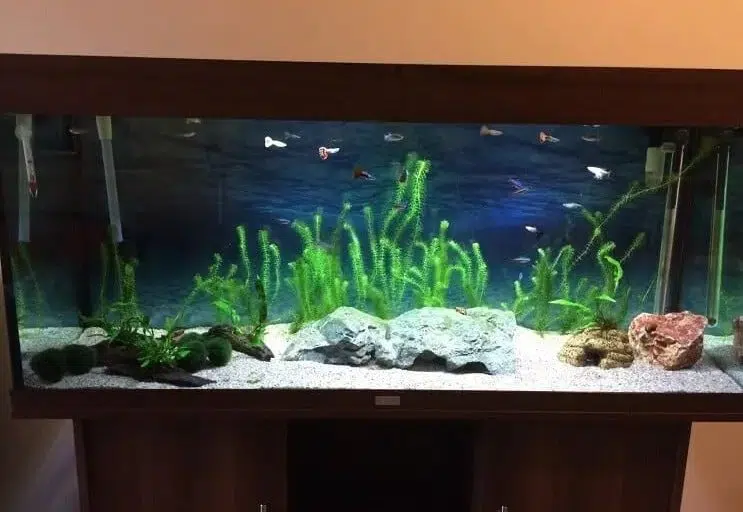ANIMALS
The Beginner’s Guide to Making an Eco-friendly Aquarium

WORDS: David Thomas PHOTOGRAPHY Supplied
Are you looking to start a home aquarium? Find out how to make it as environmentally friendly as possible!
In this article, you’ll learn how choosing your fish, buying your equipment, and even cleaning your tank can be done in the most eco-friendly ways without compromising on your aquarium.
It shouldn’t be a stretch to say that most aquarists have a deep appreciation for the Earth’s most beautiful environments and the animals that call them home. That’s why it can be upsetting for people to learn that aquarium-keeping as a hobby can have some environmentally damaging consequences.
However, no one should let fears of a negative environmental impact stop them from keeping an aquarium. In many ways, keeping an aquarium can actually prepare someone to be a better and more responsible steward of their environment, as the hobby can give you an up close and detailed look at everything from natural processes like the nitrogen cycle to the way different species interact in a shared environment.
In this article, you’ll learn how keeping an aquarium can affect the environment, as well as the best tips and tricks to enjoy your own personal aquatic ecosystem while minimizing the negative impacts of your fish tank on the natural world.
Sourcing Your Fish
Just like people adopting a puppy need to watch out for puppy mills and dishonest breeders, those looking to buy fish will have to do their research to make sure their fish are ethically and sustainably sourced. This is mostly about reducing harm to the environment, but there are also breeding and selling practices to watch out for that can harm or be cruel to the fish.
One of the most important distinctions when buying fish is between farm-raised and wild-caught fish. Most freshwater fish are farm-raised, which makes it much easier to find ethical freshwater fish. Hobbyists can also find farm-raised saltwater fish, but ocean fish in particular can be difficult or even impossible to breed in captivity. It’s possible to find ethically sourced wild-caught fish, but there are two unethical and unsustainable practices to look out for:
- Overharvesting: As aquarium-keeping has become a more popular hobby in recent years, and large saltwater tanks have become more accessible and easier for people to keep, fears about the overharvesting of tropical saltwater fish, in particular, have grown. Many prized saltwater tank showstoppers, like blue tangs and emperor angelfish, can only be harvested, not bred, and overharvesting of fish from such a delicate ecosystem could spell havoc for the world’s already endangered coral reefs.
- Dangerous Captures: In addition to concerns about the amount of fish harvesting going on, there are also dangers associated with certain popular harvesting techniques. One common method involves using cyanide or another toxin to stun the fish, making them slower and easier to catch, but also doing serious damage to the local ecosystem in the process. As with overharvesting, the dangers of this are most acute with tropical reef fish.
These concerns don’t mean you can’t keep saltwater fish, tropical reef fish, or wild-caught fish in general, but people interested in these species must do their research to ensure their own specimens are ethically sourced and harvested. For those looking for tropical fish, the Marine Aquarium Council certifies ethical suppliers around the world. For other species, potential owners should look through hobbyists’ forums, research the species, or consult with their local aquarium shop to find out the best and most sustainable way to acquire a specimen.
These research methods will also help aquarists avoid fish that have been “juiced,” or had their already bright colors artificially enhanced with injected dye. This practice is cruel and will harm the long-term health of your fish, so avoid juiced fish if possible.
Powering Your Tank
Fish tanks, unfortunately, require power to run, sometimes a lot of power. Fortunately, there are several ways to reduce the amount of power your fish tank consumes without compromising the beauty of the tank or the health of the fish inside.
The easiest and most obvious way to minimize the amount of electricity your tank consumes is to keep a smaller tank. The more water you have in your tank, the more energy is required to heat, light, filter, oxygenate and pump it.
You can also reduce your tank’s energy consumption by making smart decisions about how you stock it. Freshwater tanks generally consume less energy than saltwater tanks, in part because one of the biggest energy gobblers is temperature. A difference of only a few degrees in the optimal water temperature for your fish can make a drastic difference in your energy use, so consider choosing species that thrive in colder or even room temperature water.
Another parameter to look at when choosing how to stock a tank that consumes less energy is light usage. Many aquarists love stocking their tanks with live plants, which often also has benefits for the fish inside the tank. These plants will require more light, though, and those more powerful lights running for longer will consume more energy.
Fortunately, even if you have a large tank that requires a lot of light and high temperatures to keep the fish healthy, you can still cut your energy use by making smart decisions about what equipment you buy. For the most part, modern equipment is highly efficient and uses much less energy than the same piece of equipment would have 10 years ago. These pieces might be more expensive to buy at the outset, but in the long run, you’ll know you’re saving money on your energy bills as well as helping the environment.
Reducing and Reusing Waste
The waste product aquariums produce the most of is water, as most tanks require weekly or bi-weekly water changes. This leftover water will be contaminated with fish waste and other things that make it unsafe for most uses, but used aquarium freshwater can still be used to water potted plants, gardens, or the lawn; the waste and byproducts in the water will actually benefit the plants and act as a source of nutrients.
Another way fish tank waste can benefit your garden is when your fish and plants, sadly, die, as will happen eventually. Despite what popular culture suggests, flushing even a dead fish down the toilet is bad for your plumbing and can introduce bacteria and unwanted chemicals into your waterways. Instead, consider burying a deceased fish in the garden to provide a natural fertilizer.
Probably the easiest way to reduce the amount of waste your fish generate is by regulating how much you feed them and when. To prevent contamination of the water, food that is uneaten after five minutes or so sometimes needs to be cleared from the tank and thrown away. Once you get a feel for how much your fish eat, try to avoid overfeeding them; this will be better for your fish and your aquarium, but it will also reduce the amount of waste you generate and, as an added bonus, your food bills.
Like owning any pet, fishkeeping has environmental impacts, and irresponsible fishkeeping can have seriously negative ones, especially as the hobby grows in popularity and generates enough money to fund a global industry. However, there are plenty of ways to maintain a beautiful, healthy aquarium without doing significant damage to the beautiful, healthy planet that we and our fishy friends all call home.








